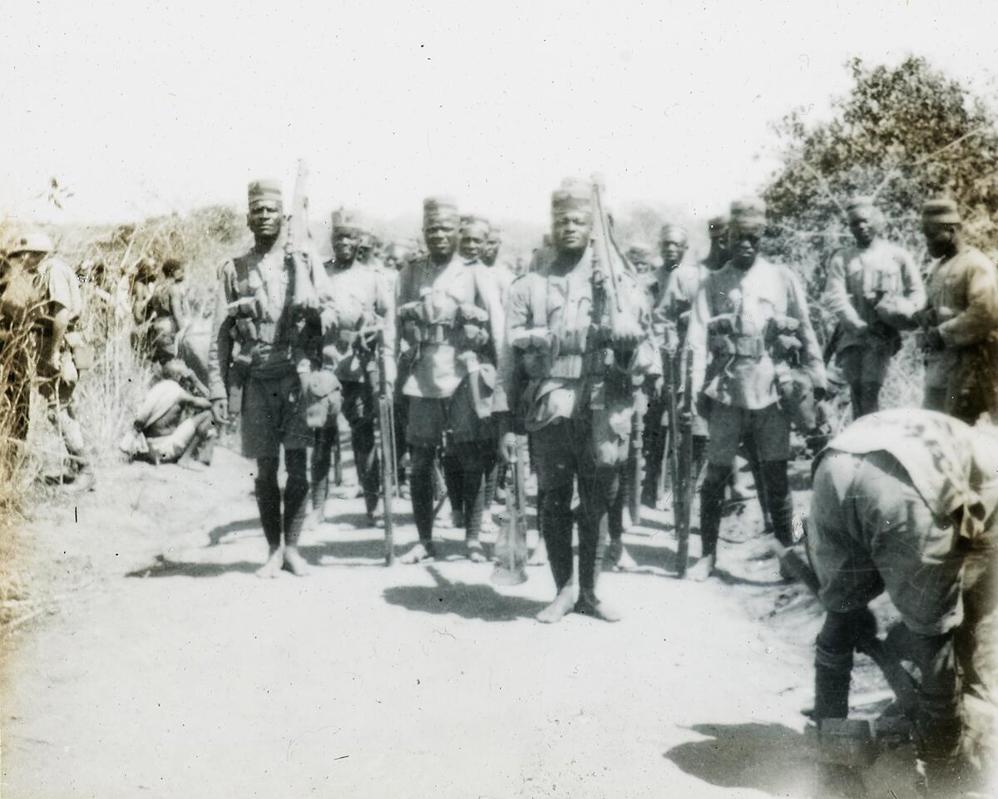01 December 2025
Malawi Voices: Commonwealth War Graves’ work in Malawi
Discover our pioneering work commemorating and uncovering the stories of Malawi’s war dead.
Commonwealth War Graves in Malawi
In October 2023, Commonwealth War Graves signed a formal partnership with the Malawi Defence Force (MDF) and the government Department of Museums and Monuments.
This was the first part of an ongoing collaboration to rectify historical injustices in commemoration, and, when possible, remember by name the Malawian servicemen who lost their lives in service to the British Empire during the First World War.
Since then, the Non-Commemoration Programme team has worked on a variety of projects in Malawi that will help us achieve our programme goals.
Commemorating Malawi’s war dead

Image: The Zomba 1914-1918 (King's African Rifles) Memorial
The first step of the programme was the designation of the King’s African Rifles Memorial, Zomba, as the official point of commemoration for around 1,300 African soldiers who served in Malawi and who lost their lives in the Great War.
This marked the first stage of the broader, ongoing programme, working alongside our Malawian partners to raise awareness of First and Second World War heritage sites across the country.
Each of these soldiers’ names has been officially entered into our records, ensuring their official commemoration by Commonwealth War Graves; a tremendous step in recognising the contribution made and loss endured by these men during the First World War in East Africa.
The Non-Commemoration Programme continues to work with our partners to research and uncover more names of Malawi’s war dead.
Following on from this, our maintenance teams in Malawi repaired the boundary wall at Zomba Town Cemetery, set in the heart of Malawi’s former colonial capital. In doing so, the cemetery’s nearly 60 war graves will be preserved, ensuring the site will remain a permanent part of Malawi’s heritage landscape.
Preserving Malawian voices

Image: This unique collection of Malawian veterans' testimonies is an important part of ensuring these soldiers' experiences are never forgotten.
We recently catalogued over 60 cassette tapes featuring more than 90 interviews with Malawian veterans of the First and Second World Wars.
These interviews were conducted by historian Melvin E. Page and his colleagues in the early 1970s, capturing the experiences of soldiers of the King’s African Rifles (KAR), primarily in the First World War. Melvin is now Emeritus Professor of History, East Tennessee State University.
Professor Page donated the collection to the Commonwealth War Graves Archive, ensuring it will be preserved for posterity and for future generations to access and learn from.
Professor Page said: “Fifty years after collecting reminiscences of Africans who recalled the First World War, I am especially pleased the Commonwealth War Graves Commission has found a home for many of the original recordings.
“It is my hope the actual spoken words of Africans themselves, made available in their own country, might one day encourage (in this case Malawians) to realise the human experiences of their ancestors.”
Many veterans could not read or write, so creating recordings of their testimonies became the only method of capturing and preserving their stories.
The true value of these recordings is first-hand testimonies from those who fought in some of the most overlooked World War theatres and campaigns.
The interviews recall stories of veterans serving across a variety of roles within the KAR, from cooks and clerks to frontline soldiers (Ascari) and the all-important carriers and porters (mtengatenga).
Each testimonial provides us with unique insight into what it meant to be a Malawian serviceman during the World Wars. From the recruitment process and training to individual perspectives on war and the inequalities and hardships endured, these are windows into a nearly forgotten world.
Some highlights include:
“From here, I went to Nairobi. There I spent six months; after that we went to the front line and began fighting. It was terrible. We run after each other. We were ten in our patrol group. All of my friends were killed… The Europeans were there. They pulled me to safety while the firing was going on.” – Daisa Songolo
“I am telling you that I was a champion! I instructed the person who used to fire the mortar, through the radio, that he should fire. So, he did. The bullets collided with that of the German in the air. Our bullet destroyed the Germans. So, I gave a victory cry: Nyasaland is Fire! Nyasaland is fire!” – Khobviwa Juwa
“The name of the dreadful disease was later learnt to be influenza. We learnt the name at the end of the war in 1919. This killed a lot of people at war, especially the mtengatenga.” – Jonathan Phiri
Recorded in two of Malawi’s native languages, Chichewa and Chiyao, the interviews were then transcribed by volunteers into English. The transcriptions were collected into three bound volumes, all of which are available in our archive, either online or in person.
Malawi in the World Wars
The First World War

Image: Malawian King's African Rifles soldiers preparing to march (University of Southern California)
Malawi, known as Nyasaland during the World Wars, was a British Protectorate. As such, it was a major manpower reservoir for African campaigns during the two conflicts. Enlisted men served in a variety of roles, particularly as Ascari soldiers or mtengatenga carriers and porters.
Nyasaland’s strategic location on the southern approaches of German East Africa (covering modern-day Tanzania, Rwanda, and Burundi) ensured the protectorate was drawn into the First World War.
Tens of thousands of men were recruited locally, serving in the King’s African Rifles. As many as 75,000 soldiers served in the KAR in East Africa during the Great War. Their numbers were dwarfed by the volume of men recruited as mtengatenga.
Organised into units like the East African Military Bureau, over a million men served as carriers in the First World War East Africa Campaign. They were not just recruited from East Africa, with units such as the South African Native Labour Corps and Sierra Leone Carrier Corps serving in the campaign.
Their service was utterly essential. Transport and logistics were the most significant problems facing combatants in East Africa. With few all-weather roads, a lack of vehicles, and pack animals susceptible to tropical diseases, the only solution was human porterage.
For every combat soldier Britain deployed in East Africa, it’s estimated that around six carriers were needed for support.
The work of the mtengatenga was arduous, difficult, and dangerous. Unarmed, the carriers and porters were still exposed to frontline fire or ambush. Sickness was a major killer, with dysentery, tuberculosis, and especially malaria, taking a heavy toll on the carrier corps.

Image: Mtengatenga carriers were essential to the war effort in East Africa (University of Southern California)
As many as 88,000 African labourers died in the East African Campaign. Some 19,000 men of the KAR died in British service across East Africa.
East Africa differed from the set-piece battles of the Western and Eastern Fronts. The war here was one of movement, attempted envelopments, and guerrilla warfare as fighting turned into the World War One battlefields of the African interior.
German General Paul von Lettow-Vorbeck fought a smart war against the British. Heavily outnumbered, he relied on cunning, ambush, and movement to outsmart and outmanoeuvre his opponents.
Never conclusively defeated in battle, Lettow-Vorbeck was forced to surrender following the signing of the Armistice in Europe. As messages from the Western Front were delayed reaching colonial authorities, the war in Africa did not officially end until 23 November 1918.
Malawi in the Second World War
Nyasaland once more supplied British forces with manpower when the Second World War broke out in September 1939. Over the course of the war, around 19,000 men served in the King’s African Rifles, fighting on battlefields close to home and far overseas.
As well as in the Abyssinian Campaign (fought over modern-day Eritrea, Ethiopia, and Somalia), men from East Africa served in the Middle East and in Burma (present-day Myanmar).
Commonwealth War Graves sites in Malawi
Commonwealth War Graves by name some 1,500 servicemen in Malawi at 11 sites, ranging from purpose-built war memorials and cemeteries to individual graves in local and municipal churchyards.
Zomba 1914-1918 (King’s African Rifles Tower) Memorial
 Image: Since 2023, the Zomba 1914-1918 (King's African Rifles Tower) Memorial
Image: Since 2023, the Zomba 1914-1918 (King's African Rifles Tower) Memorial
Unveiled in 1924, the King’s African Rifles Memorial, Zomba was paid for by public subscriptions to commemorate the men of the 1st and 2nd King’s African Rifles who died in service to the British Empire in the Great War.
The tower’s base forms an octagonal cloister, holding eight brass tablets, bearing the names of over 1,300 East African servicemen. Each tablet is a roll of honour, naming men of a specific KAR battalion.
The men commemorated by the KAR Memorial have no known war grave, or their final resting places could not be maintained.
Another unique aspect of the King’s African Rifle Memorial is its magnificent clock tower, making it one of, if not the, only Commonwealth War Graves memorial to boast this architectural feature.
As mentioned earlier, the King’s African Rifle Memorial in Zomba is the Commonwealth War Graves Commission’s official point of commemoration for the men listed on its brass memorial tablets.
For this purpose, it is known as the Zomba 1914-1918 (King’s African Rifles Tower) Memorial.
The Commonwealth War Graves Non-Commemoration Programme
The CWGC Non-Commemoration Programme had a clear mandate: to ensure all those who died in the world wars, no matter where they were, where they died or how they died are remembered equally.
Our historians work with global and state archive materials to direct their research. This allows us to yield important information – we can identify missing names, understand casualty numbers, and identify likely burial locations, as well as reinstate abandoned graves.
Our operations experts, heritage managers and community engagement experts in countries then consult with local communities, governments, institutions, architects, and global heritage experts on the most appropriate form of commemoration.
We work with architects and heritage experts, who enable us to create new memorials for what is our largest piece of work since the Second World War. Every name we recover is a person no longer forgotten, every community and stakeholder engaged with goes some way to righting a historical wrong, and combined these important programmes ensure all those who lost their lives serving the Commonwealth in the First and Second War are equally remembered.

